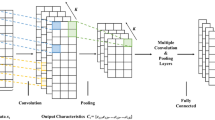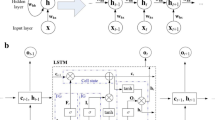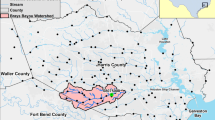Abstract
For predicting catchment runoff with data-driven methods, a long historical database of measurements is required. The current study focuses on the assessment of a deep learning model named long short-term memory (LSTM) for rainfall–runoff relationship with different training data size. The developed model has been evaluated on twenty catchments with diverse hydrological conditions obtained from the freely available CAMELS dataset. In order to prove the efficiency of the proposed model for runoff prediction, we test its performances against the traditional feed-forward neural network model. The studied models have been trained with the same input parameters and different size of training data to show the effect of data length on the prediction performances. To this end, the length of training data was varied from 3 to 15 years, while the model was tested on 10 years of data. The results show that the deep LSTM outperforms the traditional model in terms of statistical indicators over different size of training sets. The proposed deep LSTM model can predict runoff with acceptable performances using 9 years of data length in the training procedure, a result that improves when using 12 years. In addition, it has been proven that the deep LSTM model may be efficient even when using small data size (3 years) compared to its benchmarked model which require 9 years for similar results. Thus, the LSTM network is a powerful deep learning model able to learn the behavior of rainfall–runoff relationship with a minimum data length.









Similar content being viewed by others
References
Addor N, Nearing G, Prieto C, Newman AJ, Le Vine N, Clark MP (2018) Selection of hydrological signatures for large-sample hydrology. Earth arXiv: 12 Feb 2018 Web
Aggarwal CC (2018) Neural networks and deep learning. Springer 10:978–983
Anctil F, Perrin C, Andréassian V (2004) Impact of the length of observed records on the performance of ANN and of conceptual parsimonious rainfall–runoff forecasting models. Environ Model Softw 19:357–368
Ayzel G (2019) Does deep learning advance hourly runoff predictions? In: Sergey I Smagin, Alexander A Zatsarinnyy (eds): 5th International conference information technologies and high-performance computing (ITHPC-2019), Khabarovsk, Russia: CEUR Workshop Proceedings
Biondi D, Freni G, Iacobellis V, Mascaro G, Montanari A (2012) Validation of hydrological models: conceptual basis, methodological approaches and a proposal for a code of practice. Phys Chem Earth Parts A/B/C 42:70–76
Brath A, Montanari A, Toth E (2004) Analysis of the effects of different scenarios of historical data availability on the calibration of a spatially-distributed hydrological model. J Hydrol 291:232–253
Chen SM, Wang YM, Tsou I (2013) Using artificial neural network approach for modelling rainfall–runoff due to typhoon. J Earth Syst Sci 122:399–405
Chen J, Zeng G-Q, Zhou W, Du W, Lu KD (2018) Wind speed forecasting using nonlinear-learning ensemble of deep learning time series prediction and extremal optimization. Energy Convers Manag 165:681–695
Gebremichael M, Hossain F (2010) Satellite rainfall applications for surface hydrology. Springer, Berlin
Ghimire S, Deo RC, Raj N, Mi J (2019) Deep solar radiation forecasting with convolutional neural network and long short-term memory network algorithms. Appl Energy 253:113541
Graves A, Mohamed A-R, Hinton G (2013) Speech recognition with deep recurrent neural networks. In: 2013 IEEE international conference on acoustics, speech and signal processing. IEEE, pp 6645–6649
Guermoui M, Rabehi A, Benkaciali S, Djafer D (2016) Daily global solar radiation modelling using multi-layer perceptron neural networks in semi-arid region. Leonardo Electron J Pract Technol 28:35–46
Gupta VK, Sorooshian S (1985a) The automatic calibration of conceptual catchment models using derivative-based optimization algorithms. Water Resour Res 21:473–485
Gupta VK, Sorooshian S (1985b) The relationship between data and the precision of parameter estimates of hydrologic models. J Hydrol 81:57–77
Hochreiter S, Schmidhuber J (1997) Long short-term memory. Neural Comput 9:1735–1780
Hong Y, Zhang Y, Khan SI (2016) Hydrologic remote sensing: capacity building for sustainability and resilience. CRC Press, Boca Raton
Hu C, Wu Q, Li H, Jian S, Li N, Lou Z (2018) Deep learning with a long short-term memory networks approach for rainfall–runoff simulation. Water 10:1543
Jeong DI, Kim YO (2005) Rainfall–runoff models using artificial neural networks for ensemble streamflow prediction. Hydrol Process Int J 19:3819–3835
Jimeno-Sáez P, Senent-Aparicio J, Pérez-Sánchez J, Pulido-Velazquez D (2018) A comparison of SWAT and ANN models for daily runoff simulation in different climatic zones of Peninsular Spain. Water 10:192
Kingma DP, Ba J (2014) Adam: a method for stochastic optimization. arXiv:1412.6980
Kratzert F, Klotz D, Brenner C, Schulz K, Herrnegger M (2018) Rainfall–runoff modelling using long short-term memory (LSTM) networks. Hydrol Earth Syst Sci 22:6005–6022
Levenberg K (1944) A method for the solution of certain non-linear problems in least squares. Q Appl Math 2:164–168
Marquardt DW (1963) An algorithm for least-squares estimation of nonlinear parameters. J Soci Ind Appl Math 11:431–441
Merz R, Parajka J, Blöschl G (2009) Scale effects in conceptual hydrological modeling. Water Resour Res 45:W09405
Moriasi DN, Arnold JG, Van Liew MW, Bingner RL, Harmel RD, Veith TL (2007) Model evaluation guidelines for systematic quantification of accuracy in watershed simulations. Trans ASABE 50:885–900
Newman AJ et al (2015) Development of a large-sample watershed-scale hydrometeorological data set for the contiguous USA: data set characteristics and assessment of regional variability in hydrologic model performance. Hydrol Earth Syst Sci 19:209
Panda RK, Pramanik N, Bala B (2010) Simulation of river stage using artificial neural network and MIKE 11 hydrodynamic model. Comput Geosci 36:735–745
Perrin C, Oudin L, Andreassian V, Rojas-Serna C, Michel C, Mathevet T (2007) Impact of limited streamflow data on the efficiency and the parameters of rainfall–runoff models. Hydrol Sci J 52:131–151
Remesan R, Mathew J (2015) Hydroinformatics and data-based modelling issues in hydrology. In: Hydrological data driven modelling. Springer, pp 19–39
Ruder S (2016) An overview of gradient descent optimization algorithms. arXiv:1609.04747
Solaimani K (2009) Rainfall-runoff prediction based on artificial neural network (a case study: Jarahi watershed). Am–Eurasian J Agric Environ Sci 5:856–865
Srivastava S, Lessmann S (2018) A comparative study of LSTM neural networks in forecasting day-ahead global horizontal irradiance with satellite data. Sol Energy 162:232–247
Thornton PE, Thornton MM, Mayer BW, Wilhelmi N, Wei Y, Devarakonda R, Cook R (2012) Daymet: daily surface weather on a 1 km grid for North America, 1980–2008. Oak Ridge National Laboratory (ORNL) Distributed Active Archive Center for Biogeochemical Dynamics (DAAC)
Tokar AS, Johnson PA (1999) Rainfall–runoff modeling using artificial neural networks. J Hydrol Eng 4:232–239
Wang H, Yang Z, Yu Q, Hong T, Lin X (2018) Online reliability time series prediction via convolutional neural network and long short term memory for service-oriented systems. Knowl Based Syst 159:132–147
Wöllmer M, Kaiser M, Eyben F, Schuller B, Rigoll G (2013) LSTM-modeling of continuous emotions in an audiovisual affect recognition framework. Image Vis Comput 31:153–163
Acknowledgements
This work was developed with the support of the Directorate General for Scientific Research and Technological Development DGRSTD in addition of the PRFU-MESRS Project (Code# A17N01UN230120180001).
Author information
Authors and Affiliations
Corresponding author
Ethics declarations
Conflict of interest
The authors declare that they have no conflict of interest.
Additional information
Publisher's Note
Springer Nature remains neutral with regard to jurisdictional claims in published maps and institutional affiliations.
Rights and permissions
About this article
Cite this article
Boulmaiz, T., Guermoui, M. & Boutaghane, H. Impact of training data size on the LSTM performances for rainfall–runoff modeling. Model. Earth Syst. Environ. 6, 2153–2164 (2020). https://doi.org/10.1007/s40808-020-00830-w
Received:
Accepted:
Published:
Issue Date:
DOI: https://doi.org/10.1007/s40808-020-00830-w




